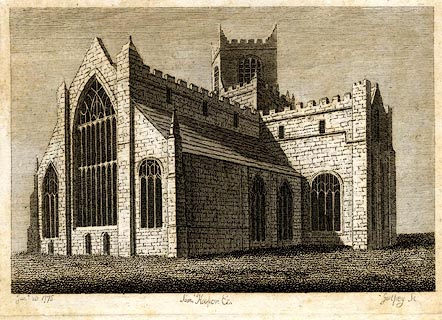

Dove Cottage : 2008.107.531
image:-
© see bottom of page

click to enlarge
Included in The Antiquities of England and Wales, by Francis Grose,.
There is descriptive text below the print and on the reverse:-
KERTMELE, OR CARTMELE, PRIORY, LANCASHIRE.
THIS was a priory of regular canons, of the order of St. Augustine, dedicated to the Virgin Mary, and founded A.D. 1188. by William Mareschal, Earl of Pembroke; who by his charter directed that it should for ever remain an independant priory; that it should never be raised to the dignity of an abbey; and that upon the death of the prior, the canons should present to him, or his successor, two of their convent, one of whom he was to nominate to the office of prior. Having settled these and some other particulars, he concludes in the following manner: "This house I have founded for the increase of our holy religion, giving and granting to it every kind of liberty the heart can conceive, or the mouth utter; and whosoever in any way infringe upon these their immunities, or injure the said monastery, may he incur the curse of God, of the blessed Virgin and all the saints, as well as my particular malediction."
BY two different charters these canons were endowed by the above-named founder with all his lands of Kertmele, together with the church and its dependencies; likewise the church of Balisar, with the chapel of Balunadan and its appendages; also the town of Kiros in Ireland, with the advowson of its church, and all appurtenances.
ADA de Winterthwaiter, Thomas de Kelilstal, and Elias, son of Goditha de Stavely, were benefactors to this house. The charters of the founder were confirmed by Edward 3d. but probably had been called in question in the reign of Henry 3d; for by the rolls of the 7th of that king, cited in Madox's History of the Exchequer, it appears, that the prior of Cartmele paid a fine of one Palfrey to have his charter and liberties amended.
IN the 26th of Henry 8th, this priory was rated at 91l. 16s. 3d. per ann. Dugdale, 124l. 2s. 1d. Speed, 212l. 11s. 10d. second valuation. Here at the dissolution were reckoned ten religious and thirty-eight servants. The bells, lead, and goods were estimated at 274l. 13s. 9½d. The debts owing by the house amounted to 59l. 12s. 8d. Anno 1553, here remained in charge 2l. in fees. The site of the monastery was granted 38th Hen. 8th. to Thomas Holcroft. The church is now converted to parochial uses; the patron thereof Sir James Lowther.
MR. PENNANT, in his Tour through Scotland, gives the following account of the present state of the remains of this convent:
"THREE miles from the shore is Cartmel, a small town, with most irregular streets, lying in a vale, surrounded by high hills. The gateway of the monastery of regular canons of St. Austin, founded in 1188, by William Mareschal, Earl of Pembroke, is still standing. But this had long been holy ground, having, about the year 677, been given to St. Cuthbert, by Elfrid, king of Northumberland, with all its inhabitants still British. The church is large, and in the form of a cross; the length is 157 feet: the transept 110: the height 57. The steeple is most singular, the tower being a square within a square; the upper part being set dragonally within the lower. The inside of the church is handsome and spacious: the centre supported by four large and fine clustered pillars: the west part more modern than the rest, and the pillars octagonal. The choir beautiful, surrounded with stalls, whose tops and pillars are finely carved with foliage, and with the instruments of the passion above.
"ON one side is the tomb-stone of William de Walton, with a cross on it. He was either fist or second prior of this place. The inscription is only, Hic jacet Frater Wilelmus de Walton, Prior de Cartmel.
"ON the other is a magnificent tomb of a Harrington and his lady, both lie recumbent beneath a fine carved and open work arch, decorated with variety of superstitious figures; and on the surbase are grotesque forms of chaunting monks. He lies with his legs across, a sign that he obtained that privilege by the merits of his pilgrimage. He is said to have been one of the Harringtons of Wrasholm Tower; his lady a Huddleston of Millam castle. It is probable that his is the effigies of Sir John de Harrington, who, in 1305, was summoned by Edward 1st, with numbers of other gallant gentlemen, to meet him at Carlisle, and attend him on his expedition into Scotland; and was then knighted, along with Prince Edward, with bathing, and other sacred ceremonies.
"THE monument erected by Christopher Rawlinson, of Cark-Hall, in Cartmel, deserves mention, being in memory of his grand-father, father and mother; the last a Monk, desended from Thomas Monk of Devonshire, by Frances Plantagenet, daughter and co-heir of Arthur viscount Lisle, son of Edward 4th; and this Christopher dying without issue, was the last male by the mother side of that great line.
"IN a side chapel is the burial place of the Lowthers, among other monuments is a neat, but small one of the late Sir William."
This view was drawn anno 1772.
[Jan ] 20 1775 / Saml. Hooper ex. / Godfrey Sc / KERTMELE, OR CARTMELE PRIORY, LANCASHIRE. / ...
 Kertmele, or Cartmele Priory, Lancashire
Kertmele, or Cartmele Priory, Lancashire